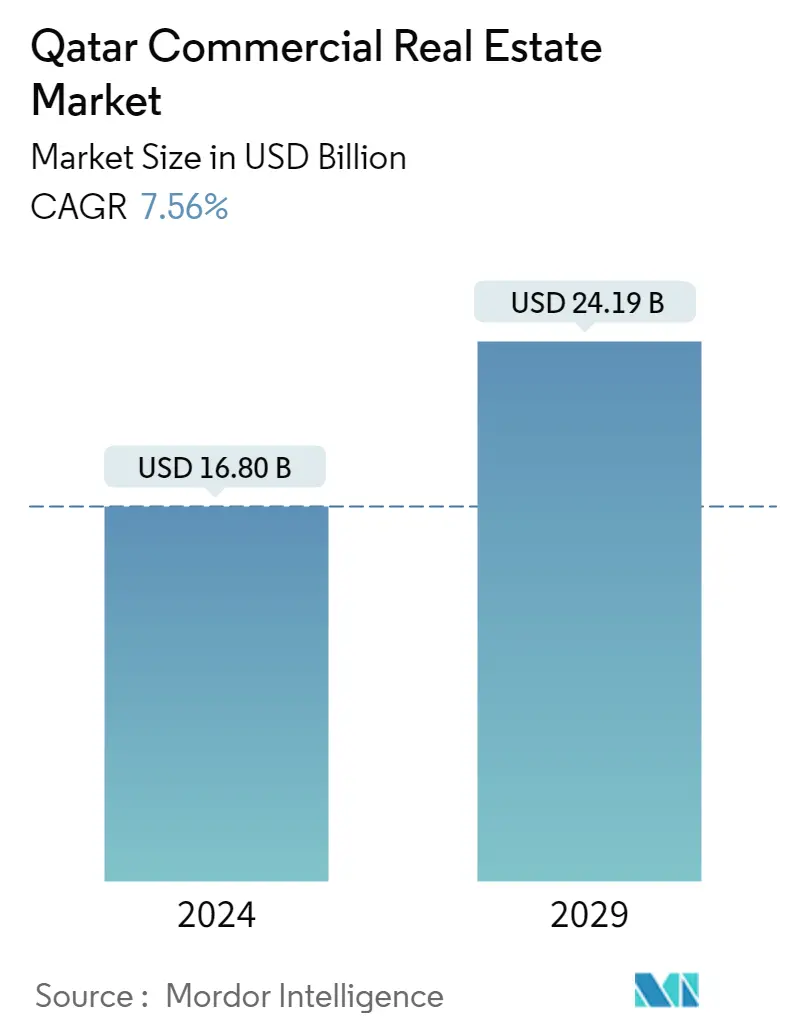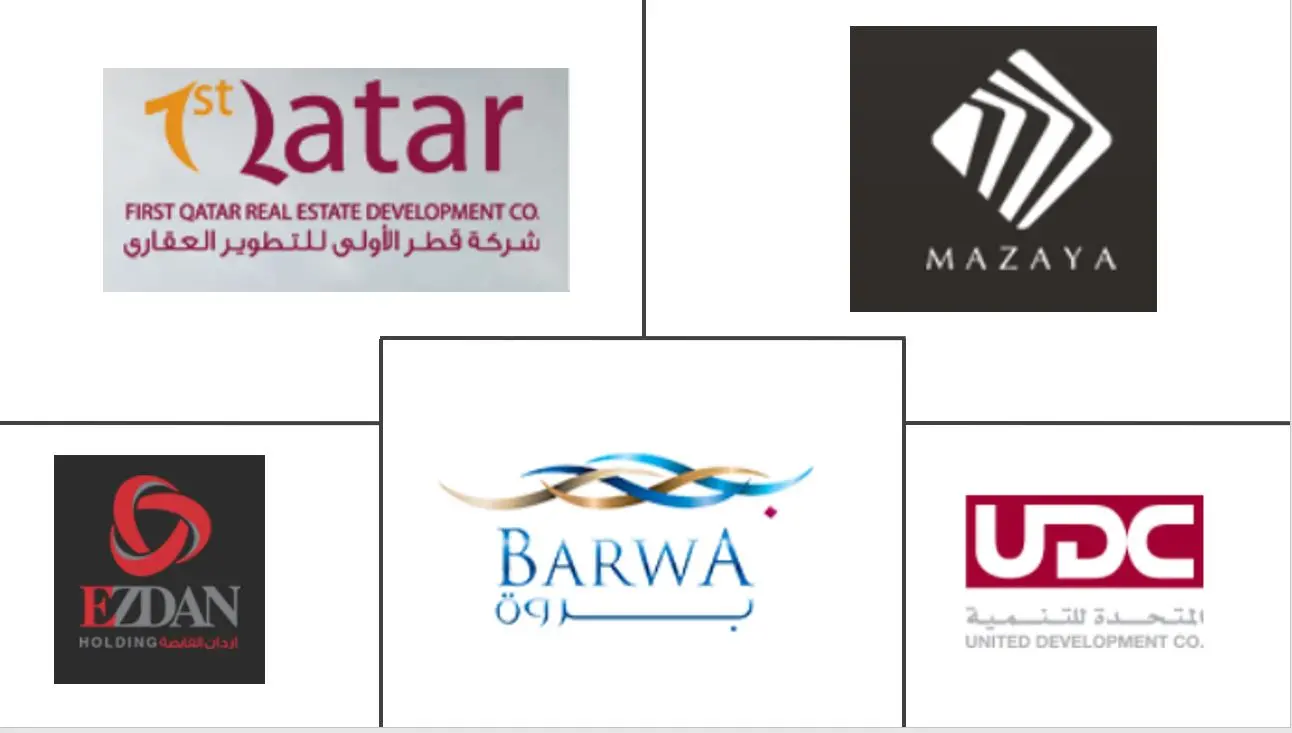Market Size of Qatar Commercial Real Estate Industry

| Study Period | 2020 - 2029 |
| Base Year For Estimation | 2023 |
| Market Size (2024) | USD 16.80 Billion |
| Market Size (2029) | USD 24.19 Billion |
| CAGR (2024 - 2029) | 7.56 % |
| Market Concentration | Low |
Major Players
*Disclaimer: Major Players sorted in no particular order |
Qatar Commercial Real Estate Market Analysis
The Qatar Commercial Real Estate Market size is estimated at USD 16.80 billion in 2024, and is expected to reach USD 24.19 billion by 2029, growing at a CAGR of 7.56% during the forecast period (2024-2029).
- Qatar's economy is one of the fastest-growing economies in the world. Some of the major factors driving the growth of commercial real estate in Qatar are increasing construction activities, GDP growth, and the introduction of various policies by the government. The majority of the construction activities happening in the country are for high-end residential towers, white-collar office spaces, luxury hotels, and shopping malls. International events, such as the 2022 FIFA World Cup, drew nearly 1.5 million fans, which supported the demand for hotel rooms in 2022. This is expected to boost the hospitality sector in the country, as Qatar currently has around 26,500 hotel rooms, and it is anticipated that the country may add 15,000 rooms in the coming years.
- The retail space growth also doubled in the last three years, and it is expected to grow by nearly 50% more, with many new malls scheduled to open in the upcoming years. Qatar is also witnessing a rising demand for infrastructure and logistics, and events such as the 2022 FIFA World Cup are driving more demand for logistics and warehouses in the country. Qatar's government has also introduced foreign-ownership laws for various asset classes in the country, which has benefited the real estate market. As per this new law, all asset classes, including offices, shops, and residential villas, in a compound are legalized for freehold ownership.
- There is a significant increase in the number of market players in Qatar, primarily driven by infrastructure development and construction activities happening in the country. The Qatari real estate market is also witnessing innovations and improvements, such as increased public-private partnerships by the government, which is driving more companies to enter the country's real estate market.
- The impact of COVID-19 on the Qatar commercial real estate market is evident through the standstill of office expansion plans, minimal sales, and numerous deferments in leases. Customers are deferring purchases across the sector, which may result in significant revenue disruption and reduced demand and realizations.
Qatar Commercial Real Estate Industry Segmentation
Qatar commercial real estate market report aims to provide a detailed analysis of the Qatari commercial real estate market. It focuses on the market dynamics, technological trends, insights, government initiatives taken in the commercial real estate sector, and the impact of COVID-19 on the market. The report also analyzes the key players present in the market and the competitive landscape in the Qatari commercial real estate market.
The commercial real estate market in Qatar is segmented by type (offices, retail, industrial & logistics, multi-family, and others (such as hospitality)) and key cities (Doha, Al Wakrah, Al Rayyan, and Rest of Qatar). The report offers the market sizes and forecasts for the Qatar Commercial Real Estate Market in value (USD) for all the above segments.
| By Type | |
| Offices | |
| Retail | |
| Industrial & Logistics | |
| Multi-family | |
| Other Types (such as Hospitality) |
| By Key Cities | |
| Doha | |
| Al Wakrah | |
| Al Rayyan | |
| Rest of Qatar |
Qatar Commercial Real Estate Market Size Summary
The Qatar commercial real estate market is poised for significant growth, driven by the country's rapid economic expansion and strategic government initiatives. The market is characterized by a surge in construction activities, particularly in high-end residential towers, office spaces, luxury hotels, and shopping malls. The hosting of international events, such as the FIFA World Cup, has further stimulated demand in the hospitality sector, with a notable increase in hotel room supply anticipated. The retail sector has also seen substantial growth, with new malls set to open, reflecting a burgeoning demand for retail space. Additionally, the introduction of foreign-ownership laws has enhanced the attractiveness of the real estate market, allowing for freehold ownership of various asset classes. This regulatory environment, coupled with increased public-private partnerships, has encouraged a rise in market participants and innovations within the sector.
The commercial real estate landscape in Qatar is experiencing a resurgence post-COVID-19, with a notable recovery in office leasing transactions and an expansion in office space requirements. The hydrocarbon sector's growth has contributed to increased demand for office accommodations, particularly in the Lusail area, which is becoming a focal point for office occupiers. The supply of purpose-built office space has reached substantial levels, with prime locations offering competitive rental rates. The hotel sector, despite challenges, is expected to see a significant increase in supply, driven by the demand generated during the World Cup. The market is fragmented, with major players like Barwa Real Estate Company and Ezdan Holdings leading the charge, while online property portals are gaining traction due to rising internet penetration and a growing middle-class demographic. This competitive landscape is further shaped by strategic collaborations and comprehensive development plans aimed at enhancing Qatar's real estate offerings.
Qatar Commercial Real Estate Market Size - Table of Contents
-
1. MARKET INSIGHTS AND DYNAMICS
-
1.1 Current Economic Scenario and Consumer Sentiment
-
1.2 Commercial Real Estate Buying Trends - Socioeconomic and Demographic Insights
-
1.3 Government Initiatives and Regulatory Aspects for the Commercial Real Estate Sector
-
1.4 Insights into Existing and Upcoming Projects
-
1.5 Insights into Interest Rate Regime for General Economy and Real Estate Lending
-
1.6 Insights into Rental Yields in the Commercial Real Estate Segment
-
1.7 Insights into Capital Market Penetration and REIT Presence in Commercial Real Estate
-
1.8 Insights into Public-private Partnerships in Commercial Real Estate
-
1.9 Insights into Real Estate Tech and Startups Active in the Real Estate Segment (Broking, Social Media, Facility Management, and Property Management)
-
1.10 Impact of COVID-19 on the Market
-
1.11 Market Dynamics
-
1.11.1 Drivers
-
1.11.2 Restraints
-
1.11.3 Opportunities
-
-
1.12 Industry Attractiveness - Porter's Five Forces Analysis
-
1.12.1 Bargaining Power of Suppliers
-
1.12.2 Bargaining Power Of consumers/ Buyers
-
1.12.3 Threat of New Entrants
-
1.12.4 Threat of Substitute Products
-
1.12.5 Intensity of Competitive Rivalry
-
-
-
2. MARKET SEGMENTATION
-
2.1 By Type
-
2.1.1 Offices
-
2.1.2 Retail
-
2.1.3 Industrial & Logistics
-
2.1.4 Multi-family
-
2.1.5 Other Types (such as Hospitality)
-
-
2.2 By Key Cities
-
2.2.1 Doha
-
2.2.2 Al Wakrah
-
2.2.3 Al Rayyan
-
2.2.4 Rest of Qatar
-
-
Qatar Commercial Real Estate Market Size FAQs
How big is the Qatar Commercial Real Estate Market?
The Qatar Commercial Real Estate Market size is expected to reach USD 16.80 billion in 2024 and grow at a CAGR of 7.56% to reach USD 24.19 billion by 2029.
What is the current Qatar Commercial Real Estate Market size?
In 2024, the Qatar Commercial Real Estate Market size is expected to reach USD 16.80 billion.

